
The Organisation for Economic Co-operation and Development (
OECD) defines the digital divide as the “gap between individuals, households, businesses, and geographic areas at different socio-economic levels about both their opportunities to access information and communication technologies (ICTs) and to their use of the Internet for a wide variety of activities.” Simply put, the digital divide can be explained as the inequalities between the digital haves and the have-nots in terms of their access to the internet and the ICTs. Due to the ever-increasing importance of the internet and the rapid digital transformation on account of the COVID-19 pandemic, the UN Deputy Secretary-General Amina Mohammed has even claimed that the digital divide has the potential to be the “
new face of inequality”.
The digital divide can be explained as the inequalities between the digital haves and the have-nots in terms of their access to the internet and the ICTs.
Whilst different parameters such as availability, affordability, and digital literacy can be used to measure the digital divide, this piece takes a simpler approach and explores the usage dimension and the physical access dimension, i.e., “use of internet” and “access to mobile phones” respectively. Using these parameters, the piece highlights the prevailing digital divide across India.
Internet users in India
As per
ITU’s World Telecommunication/ICT Indicators Database, only 43 percent of the population in India uses the internet. The IAMAI-Kantar Report
ICUBE 2020 suggests that there are 58 percent male internet users and 42 percent female internet users in India. The
National Family Health Survey 2019–21 (“NFHS”), however, shows a significantly larger gender gap in internet usage. The NFHS Report suggests that only 57.1 percent of the male population and 33.3 percent of the female population had ever used the internet. This gender gap was present across all states as demonstrated in Figure 1.
Figure 1: (%) individuals who have ever used the internet- State-wise gender divide
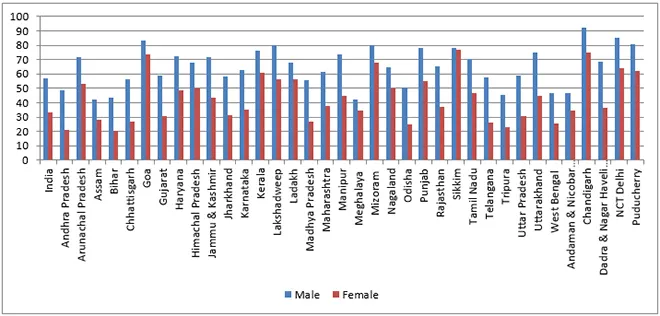 Source: Data from NFHS 2019-21
Source: Data from NFHS 2019-21
The NFHS also provides data segregation based on the rural-urban divide. Whilst 72.5 percent of the urban males and 51.8 percent of the urban females have ever used the internet, only 48.7 percent of rural males and 24.6 percent of the rural females qualify for this condition. It is interesting to note that across all states urban males have the highest percentages, whilst rural females have the lowest percentage as demonstrated in Figures 2 and 3.
Figure 2: (%) individuals who have ever used the internet- State-wise gender and rural/urban divide
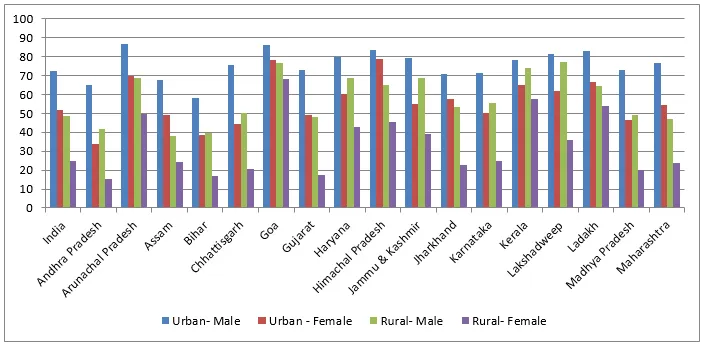 Source: Data from NFHS 2019-21
Figure 3 (%) individuals who have ever used the internet- State-wise gender and rural/urban divide
Source: Data from NFHS 2019-21
Figure 3 (%) individuals who have ever used the internet- State-wise gender and rural/urban divide
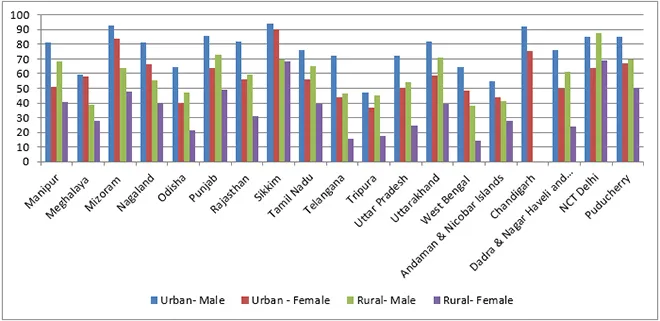 Source: Data from NFHS 2019-21 (Cont.)
Source: Data from NFHS 2019-21 (Cont.)
Further, there exists a considerable digital divide amongst different disadvantaged caste groups. For instance, some
studies even suggest that “ST individuals have 27 percentage points lower access to the Internet as compared to the other individuals”.
Mobile ownership
As per the GSMA Report
Connected Women: The Mobile Gender Gap Report 2021, 79 percent of the adult male population and 67 percent of the adult female population are mobile phone owners in India. The report also suggests that there is a general trend of increase in mobile phone ownership by women in India. The NFHS also confirms this observation as there has been a clear growth in mobile phone ownership amongst women in India between 2015–16 and 2019–21 as demonstrated by Figure 4.
Figure 4: (%) Women having a mobile phone that they use – Growth between 2015-16 and 2019-21
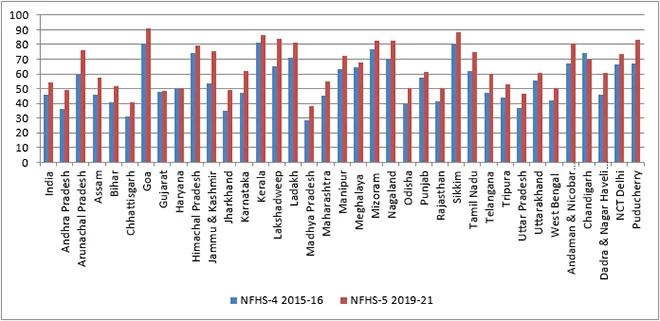 Source: Data from NFHS 2019-21
Source: Data from NFHS 2019-21
The NFHS data also provides segregation of mobile phone ownership based on the rural/ urban divide. The data shows that there exists a clear gap in mobile phone ownership wherein the general trend is that a higher percentage of urban women own mobile phones as compared to rural women. In some states and union territories such as Kerala, Ladakh, Delhi, Andaman, and Nicobar, the trend is reversed and rural women have greater access to mobile phones. The state-wise rural-urban divide in female mobile phone ownership is demonstrated in Figure 5. It is also important to note here that further gap in usage is based on
age and caste group.
Figure 5: (%) Women having a mobile phone that they use – State-wise Rural-Urban divide
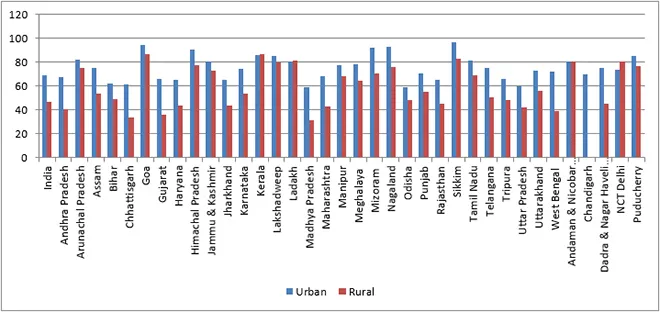 Source: Data from NFHS 2019-21
Source: Data from NFHS 2019-21
Trends of Digital Divide
As observed, there exists a grave digital divide in India wherein gaps exist in the usage of the internet and access to digital infrastructure based on gender, area of residence whether rural-urban, caste, or age. It is generally observed that men have greater access to the internet and greater ownership of mobile phones. While there might be small variances, urban men are much better off than others both in terms of access to the internet and ownership of phones when compared to urban women, rural men, and rural women. Similarly, rural women always receive the short end of the stick, for instance, though rural women have more ownership of phones than urban women, their internet access is still lower. However, it is important to note that there have been some improvements in women’s access to cell phones between 2015–16 and 2019–21 which demonstrates that the efforts to reduce the digital divide are steadily coming into fruition.
The way forward
The digital divide poses severe social implications. The inability to access technology has the potential to increase existing social exclusions and deprive individuals of essential resources. With the increasing dependence on digital technologies and the internet, the digital divide has ramifications on education, health, mobility, safety, financial inclusion, and every other imaginable aspect of life.
Whilst several government initiatives like the National Digital Literacy Mission and the Pradhan Mantri Gramin Digital Saksharta Abhiyan have been introduced to increase digital literacy, there is a need to ramp up such efforts. It is also important to improve the existing digital infrastructure to ensure physical access to ICT to different sections of society. At the same time, underprivileged groups need to be motivated to incorporate technology into their daily lives and digital skills need to be imparted to allow such a change.
The views expressed above belong to the author(s). ORF research and analyses now available on Telegram! Click here to access our curated content — blogs, longforms and interviews.



 The Organisation for Economic Co-operation and Development (
The Organisation for Economic Co-operation and Development (




 PREV
PREV


